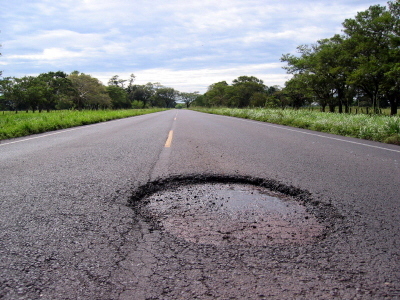
Due to their hazardous nature, potholes are often addressed quickly using temporary repair methods. These short-term fixes tend to be inefficient, however, requiring additional future repairs. Infrared pothole repair is one method that could offer a more durable solution.
How Do Potholes Form?
An important aspect in treating potholes is understanding the factors that cause them. While potholes are easily identifiable by sight, it is the activity below the surface that initiates this failure in asphalt.

Potholes are a prevalent danger on the surfaces of roads.
Moisture, such as rain and snow, has a tendency to seep into the cracks of pavement, causing the supporting soil below to weaken. As temperatures decrease, the water beneath the surface freezes, which causes the ground to expand and the pavement to rise. When the temperature increases, the ground returns to its original position but the pavement tends to stay in its raised state.
In addition to the fatigue from this freeze-thaw cycle, the pavement continues to wear with the pressure from traffic passing over the area. Chunks of asphalt gradually become loose, which leads to the formation of a pothole. (Check out this article to learn more about the anatomy of a pothole.)
Types of Pothole Repair Methods
In the past, both temporary and semi-permanent methods have been used to repair potholes. The throw-and-roll repair is one of the most basic temporary techniques used to patch potholes. This method entails placing the patching material into the pothole and then allowing it to become compacted by a vehicle.
While temporary repairs are valued for their speed and simplicity, they are just that: temporary. These methods typically end up being more costly in the long run as more permanent fixes are often needed down the road. Additionally, there is a greater failure rate for such expedient processes. Among other reasons, the method does not remove the loosened chunks of asphalt, and the resulting patch is subsequently full of seams and cracks to allow further water seepage.
The semi-permanent repairs dive deeper into the root of the problem by removing water and debris from the affected area before adding the patching mixture. While this alternative offers greater durability in repairing the patch, it’s also a more labor intensive process and requires more equipment in order to complete the repair.
The question then becomes “How do we develop a technique that combines both speed and reliability?” Infrared heat technology may be just the answer.
Using Infrared Heating Technology to Fix Potholes
Let’s first take a look at the steps behind this technology.
With this technique, an infrared panel is used to heat the pothole, softening the asphalt pavement into a hot mix without burning it. As it is heated and softened, the once defective asphalt is recycled and converted into a workable condition. After heating is completed, the affected area is raked back into place and more hot mix is added when necessary. The mixture is then smoothed and compacted to create a strong thermal bond between the repaired area and the surrounding road surface.
Advantages of Infrared Pothole Repair
One of the biggest advantages of the infrared heating method is that it recycles asphalt. By reworking the existing asphalt into a workable state, this process is more cost-effective and allows for faster repairs than the traditional route of having to cut out and replace asphalt. The use of recycled materials also makes this a more environmentally friendly repair option.
Infrared heating is also valued for its ability to create seamless patches. Without seams, water is prevented from trickling through the patched material and causing additional damage to the area. Thus, this method offers a more permanent solution, helping to prevent costs for additional future repairs.
Concluding Thoughts
When it comes to road repairs, efficiency in both time and cost is key. In comparison to its traditional counterparts, infrared pothole repair allows for a faster rate of completion, which translates into a decreased impact on road traffic. It also provides cost savings in regards to both labor as well as the materials used in the process, all while offering quality results.
One might say this technology is a step forward in patching up the pothole issue.



Comments (0)